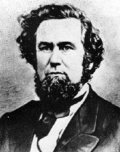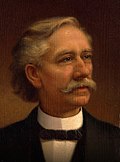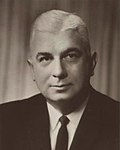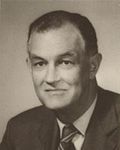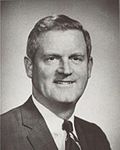Top Qs
Timeline
Chat
Perspective
List of governors of Virginia
From Wikipedia, the free encyclopedia
Remove ads
Remove ads
The governor of Virginia is the state's head of government and commander-in-chief of the state's official national guard. The first Constitution of 1776 created the office of governor, to be elected annually by the Virginia State Legislature. The governor could serve up to three years at a time, and once out of office, could not serve again for four years.[1] The 1830 constitution changed the thrice-renewable one-year term length to a non-renewable three-year term, and set the start date at the first day in January following an election.[2] This constitution also prevented governors from succeeding themselves, a prohibition that exists to the present day.[3] The 1851 Constitution increased terms to four years[4] and made the office elected by the people, rather than the legislature.[5] The commencement of the Governor's term was moved to the first day in February by the 1902 Constitution,[6] and then to the Saturday after the second Wednesday in January by the 1971 and current Constitution.[7]

If the office of governor is vacant due to death, impeachment and disqualification, or resignation, the lieutenant governor of Virginia becomes governor.[8] The office of lieutenant governor was created in 1851.[9] Prior to that a Council of State existed; it chose from among its members a president who would be "lieutenant-governor" and would act as governor when there was a vacancy in that office.[1][10] The governor and the lieutenant governor are elected at the same time but not on the same ticket. Officially, there have been 74 governors of Virginia; the acting governors are not counted.
Remove ads
Governors
Summarize
Perspective
Virginia was one of the original Thirteen Colonies and was admitted as a state on June 25, 1788.[11] Before it declared its independence, Virginia was a colony of the Kingdom of Great Britain. It seceded from the Union on April 17, 1861,[12] and was admitted to the Confederate States of America on May 7, 1861.[13] Following the end of the American Civil War, Virginia during Reconstruction constituted the First Military District, which exerted some control over governor appointments and elections. Virginia was readmitted to the Union on January 26, 1870.[14]
The federal government recognized the Restored Government of Virginia, based in Wheeling, as the legitimate government in Virginia on June 25, 1861. It elected its own slate of governors, and after West Virginia was split from Virginia on June 20, 1863, the restored government relocated to Alexandria.
Remove ads
See also
Notes
- Under the 1776 constitution, governors were ineligible to serve longer than three years successively.[17]
- Jefferson refused re-election and left office at the end of his term. As the legislature had not yet elected a successor, due in part to chaos stemming from the Raid on Richmond, Fleming acted as governor until the next election.[21][23][24]
- Nelson resigned due to ill health.[23]
- Randolph resigned to serve in the Virginia House of Delegates and promote the United States Constitution there.[32][33][29]
- Brooke resigned, having been elected Attorney General of Virginia.[29]
- Many sources say that Hardin Burnley acted as governor, either from February 7, 1799,[42] or December 7,[43] serving until he resigned due to poor health on December 11,[44] at which time John Pendleton Jr. took over as acting governor[45] until Monroe became governor on December 19. However, details of their terms are sparse and it's unknown how official their capacity was, and Sobel's entry on Wood mentions no acting governors and says that he left office on December 19.[40]
- Tyler resigned, having been confirmed to the United States District Court for the District of Virginia.[53]
- Monroe resigned, having been appointed United States Secretary of State.[47]
- Tyler resigned, having been elected to the United States Senate.[69]
- Under the 1830 constitution, governors were ineligible to serve again until three years after their term.[76]
- Tazewell resigned over disagreements with the General Assembly.[77]
- Gilmer resigned, having been elected to the United States House of Representatives for a term beginning March 4, 1841; he delayed his resignation two weeks, finally resigning due to a disagreement with the General Assembly on extradition.[83]
- After Gilmer's resignation, Patton acted as governor until the election, but the General Assembly failed to elect a successor, so the senior members of the Governor's Council each acted as governor for a year.[23]
- Under the 1851 constitution, governors were ineligible to succeed themselves.[102]
- Virginia proclaimed its secession from the Union on April 17, 1861. In response, delegates from the northwestern counties assembled at Wheeling and formed the Restored Government of Virginia, which the federal government recognized as the legitimate government of Virginia on June 25, 1861. It operated a government, including state and federal elections, over the northwestern part of the state, the counties immediately around Washington, D.C., and the eastern shore. On June 20, 1863, the northwestern counties were split into their own state, West Virginia, and the Restored Government relocated to Alexandria, and after the fall of Richmond, the government relocated to Richmond to be the sole state government.
- President Andrew Johnson issued an executive order on May 9, 1865, proclaiming that the state government run by Letcher and Smith had been illegitimate as of April 17, 1861, and that Pierpont was the legitimate governor.[108] Smith continued to attempt to claim the office until May 20.[29]
- The Reconstruction Acts placed Virginia under full military control, and General John Schofield appointed Wells provisional governor.[111]
- Wells was ordered to resign by General Edward Canby, who appointed Walker (who had already won election) in his place.
- Under the 1864 constitution, governors were ineligible to succeed themselves.[117]
- Walker ran in 1869 as a "Conservative Republican"[23] to differentiate from his opponent who was running as a Radical Republican.[114]
- Represented the Conservative Party
- Under the 1870 constitution, governors were ineligible to succeed themselves.[121]
- Represented the Republican Party
- The constitutional start date of the gubernatorial term was January 1, with no requirement for an oath; Cameron was not sworn in until January 2, presumably because January 1 was a Sunday.[127]
- Under the 1902 constitution, governors were ineligible to succeed themselves.[143]
- The constitutional start date of the gubernatorial term was February 1, with no requirement for an oath; Stuart was not sworn in until February 2, presumably because February 1 was a Sunday.[152]
- Under the 1971 constitution, governors are ineligible to succeed themselves.[195]
- Represented the Democratic Party
- Youngkin's term will expire on January 17, 2026; he will be term-limited.
Remove ads
References
External links
Wikiwand - on
Seamless Wikipedia browsing. On steroids.
Remove ads





































